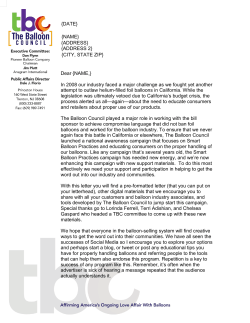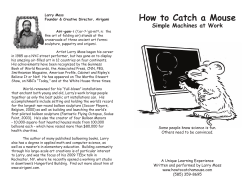
J STATIC ELECTRICITY AND WRIGGLY WORMS
STATIC ELECTRICITY AND WRIGGLY WORMS J Junior Equipment: 1. Balloons, woolly jumper or other woolly garment, tissue paper, Rice Krispies, a wall. 2. Balloons, variety of different materials, e.g. wool, cotton, nylon, etc., tissue paper 3. Balloons, string, woolly garment 4. Tissue paper (preferably coloured), pieces of coloured card, scissors, balloons, plastic comb, glue. Suggested Class Level: 1st - 2nd Preparation: THIS ACTIVITY WORKS BEST ON A DRY DAY (a bright frosty winter day works best). The activities could be repeated on a damp day, and the children could compare the results. Background information: There are two main kinds of electricity: Static and Current. Static electricity occurs when an electric charge builds up on an object. This can happen by rubbing certain things together. Everything is made up of tiny things called atoms. Atoms are so small that millions of them could fit on a pinhead! An atom has a nucleus in the centre, with electrons spinning around it (a bit like the planets revolving around the sun in our solar system). The nucleus has a number of positive charges, and the electrons have negative charges. In its normal (uncharged neutral) state an atom has the same number of positives (in the nucleus) as negatives (the electrons), which cancel each other out. Electrons, being on the outside of an atom, can come off certain things when rubbed. The thing that gets the extra electrons then becomes negatively charged (because it now has more – s than + s; and the thing that loses the electrons becomes positively charged (because it now has more +s than -s). Current electricity is a flow of electrons going along in wires, from a battery or the mains. Example of static electricity: When a balloon is rubbed against a woolly jumper, electrons move from the sweater to the balloon. The balloon now has more – s than + s, so it now has a negative charge. The sweater loses some negative charges and so becomes positively charged. Like charges (e.g. two positives or two negatives) repel each other. Unlike charges (positive and negative) attract each other. Note the similarity with the poles of magnets – like poles repel, and unlike poles attract each other). Lightning is caused by static electricity that builds up when water drops rub against ice crystals in storm clouds; huge numbers of electrons accumulate which flash out towards the ground as a huge spark. STATIC ELECTRICITY AND WRIGGLY WORMS J Junior Trigger questions: Have you ever noticed anything when you comb your hair with a plastic comb on a dry day, especially if it has been washed recently? (It makes a crackling/sparking sound). Or when you take on or off certain garments, e.g. a nylon one, on a dry day? (The same). What do you think causes this sound? (Static electricity. No details about electrons, etc. should be gone into here – this is for second level. It should be mentioned that they will learn about ‘current electricity’, i.e. the current that runs through wires, and runs lights, washing-machines, TV, etc. in higher classes). What sort of materials do you think produce static? (We will investigate) What do you know about lightning? (See above. DANGER. Opportunity for discussion about not flying kites near electricity wires, sheltering under a tree during a thunderstorm, etc.) Content: SCIENCE: Forces: electricity Materials – characteristics and properties MATHS: Measures: counting, comparing Measures: Time Data: representing data Skills: Predicting Experimenting Designing and Making Recording Crosscurricular Links: History: Story of Benjamin Franklin and the kite STATIC ELECTRICITY AND WRIGGLY WORMS J Junior Activities: 1. (a) Making static electricity (i) Blow up a balloon. Rub it on your hair (better if your hair is dry and even better if freshly-washed). What happens? (Your hair stands on end!). (ii) Blow up a balloon. Rub it against a woolly jumper. How can you tell if the balloon has static electricity? (The children could try and see if it ‘sticks’ to a wall; or can pick up small pieces of tissue paper or can make their hair stand on end). (b) Investigation: does the number of rubs make the balloon ‘stick’ to the wall longer? How How many many rubs? rubs? How How long long did did it it stick? stick? (c ) Challenge: How many Rice Krispies can the children get a charged balloon to pick up? Record the results for various number of rubs, using appropriate method for the class level, e.g. bar chart. Number of rubs/number of Rice Krispies. 2. Investigating which material produces the best ‘static’: Children should first predict which material (wool, nylon, cotton, tissue, etc) they think will produce the best static. Then ask them how they could use a fair test to find out. (e.g. using same balloon, same number of rubs, different material, how many pieces of tissue or Rice Krispies did each material pick up?). Their results should be recorded using a method appropriate to the class level. Name Name of of material/number material/number of of Rice Rice Krispies Krispies (with (with same same number number of of rubs). rubs). 3. What effect do two charged balloons have on each other when they come near? Children should first predict what they think will happen when two charged balloons are brought near each other. Hold two charged balloons near each other by strings. What happens? (They repel each other. Both balloons have the same charge – negative – so they repel.) STATIC ELECTRICITY AND WRIGGLY WORMS J Junior Activities: 4. Make a toy wormery (‘Wriggly Worms ‘) using Static electricity Cut out some worm shapes from the tissue paper. The children can decorate them with marker pens. Stick one end of each of the ‘worms’ to the card. Charge the balloon (by rubbing on a jumper) or comb (by combing hair, preferably recently- washed hair). The children can try to get the ‘worms’ to wriggle by passing the charged comb or balloon over them. 5. Can the children design and make their own dancing/wriggling toy? (Remember: Explore, Plan, Make, Evaluate). e.g. make a snake spiral out of very light (e.g. tissue) paper and get the snake to ‘stand up’ using static electricity. Safety: There are no specific dangers with these activities, but children should always be made aware of the dangers of electricity, and warned never to experiment with mains electricity. The dangers of lightning should be discussed also. Follow-up activities: 1. Which type of hair (curly, straight, long, short, newly-washed and dried) produces static electricity? (SESE Curriculum Guidelines, p. 99) 2. What happens when a charged balloon is placed near flowing water? Charged plastic ruler near a stream of water from a tap. What happens when the ruler touches the water? 3. Children can explore different materials for making static electricity by rubbing balloons or plastic pens or rulers against different materials (e.g. carpets, curtains, sofas, etc.) and see what combination of things produce static.
© Copyright 2025





















